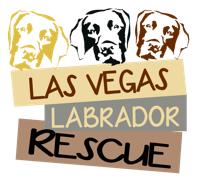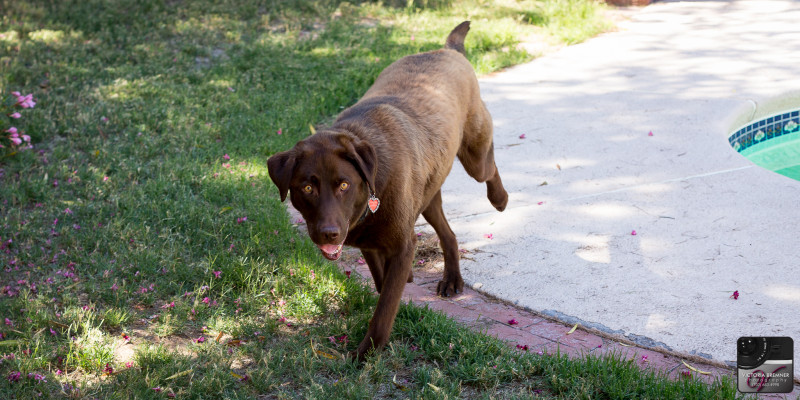Adopted: Grizzly, a 4-5 year old Chocolate Male Labrador, has found his forever home.
Here is a Bio from his foster family……..
"My name is Bonnie and I am a ‘foster mom’ with the Las Vegas Labrador Rescue (LVLR). This means that when a dog is rescued, after it is medically checked out and spayed or neutered, it goes to one of the many foster homes that are part of the LVLR team. This is an amazing Labrador that has a medical condition which took three months to diagnose and bring him back to a normal healthy, happy Labrador Retriever. Grizzly has Atypical Addison’s Disease. His current status is a happy guy looking for a forever home that meets his needs, abides by all veterinary instructions, financially able to cover increased veterinarian visits and prescriptions “estimated” to be $950.00 annually, plus normal vaccinations and/or other medical needs, and ability/willingness to provide him with a more leisurely lifestyle and drinking water available 24/7. If the above introduction seems overwhelming or out of your financial reach, you should consider looking for another Labrador Retriever. Should you request a meet & greet with Grizzly, we will most likely ask why you want him, what you know about his condition and why you believe his best direction in life is to be your Labrador Retriever.
Here’s my part of his amazing story
When Grizzly first arrived, he was in pretty tough shape. He weighed only 57 pounds, and his bones were sticking out everywhere. He showed signs of illness (no appetite, vomiting), but when he stopped drinking water, I knew it was time to bring him to the vet.
Grizzly stayed at Camino Al Norte Animal Hospital for the next two weeks where Dr. Jessica Hagstette and her team looked after him and worked non-stop to diagnose what was wrong. Two weeks in the hospital resulted in an exhaustive list of all the problems Grizzly DIDN’T have, and a dog that seemed to be feeling better with no apparent explanation, but still no diagnosis. Undeterred but convinced that Grizzly might continue to improve more happily in a known home environment, Dr. Hagstette released Grizzly. Still working on the mystery, two days later, she called us back so he could have one more test. At long last – a diagnosis!
With the new knowledge that Grizzly has Atypical Addison’s disease, a treatment plan could finally begin. Luckily, Atypical Addison’s is very treatable with a daily dose of cortisol – the chemical his adrenal glands should have been producing all along, but weren’t. Because of the numerous symptoms that can be seen with Atypical Addison’s Disease, it has earned the medical nickname The Great Imitator. Here is a link for a more clinical explanation: Addison's Disease.
Dr. Hagstette is not only an excellent veterinarian, but also a patient teacher who explained what needed to happen next. First, Grizzly needed medicine, but for this particular medicine (a form of cortisol replacement), the dose is dependent on not just the size and weight of the dog, but more importantly on its level of physical activity and stress. So the optimum dose had to be calibrated over time. Second, Grizzly needed his activity and therefore stress levels to be moderated.
Dr. Hagstette started with the most broadly used medicine at the lowest dosage, which I gave to Grizzly once a day – always at roughly the same time of day, with a meal. I also ensured that his activity levels were moderate. All dogs need exercise, Grizzly included. So we went for a ½ mile walk each day, and Grizzly also played with my two other Labs, but for periods of about 10 minutes of running, fussing over toys, catching balls, etc., and then we would all take a break so that he could rest for some hours before a second playtime. It was sometimes a challenge to always keep an eye on him, but he quickly settled into the routine.
This routine – along with a very hearty and robust diet of high quality dry dog food, continued for one month. With his new medicine, I noticed that Grizzly’s water intake went up quite a bit, and his appetite grew to the point that he would wake me up at 4am to be fed. Reports of his progress and my observations were reviewed every few days by Dr. Hagstette and also by the Director of the LVLR, and we adjusted his meal plan accordingly.
During month one, Grizzly’s appetite steadily and quickly grew. His body’s ability to process protein and fat came back online, and he started to gain some much needed weight. He was still weak, but his enthusiasm and energy level increased every day. I could even start to feel him exerting more strength when we’d go for a walk and he would try to pull me down the road faster than I wanted to walk! More importantly, I could see the happiness in his face and in the wag of his tail. I believe he knew how ill he had been, and was really overjoyed to be able to play and run and feel good again.
At the end of month one, Grizzly went back to the hospital for a physical exam and panels of blood and urine tests. Based on these results, Dr. Hagstette felt Grizzly’s extra water and increased appetite, both of which can be caused by certain types of cortisol replacement, might be reduced or eliminated on a slightly different formulation. So he was switched to the new version – with more good news being that it was also a lower dose (4gm instead of 5mg), and we started another month of observation.
During month two, Grizzly’s excessive water intake came down a bit, and he stopped crying for food at 4am. His water intake is still higher than normal, but this is a small price to pay for a full recovery. He has continued to improve in all directions. He is now 79 pounds, which for a big, tall, long, male Labrador Retriever, is right where he needs to maintain. No more bones are visible anywhere, and when he pulls on the leash (a habit I am now working to break him of), I can feel even more strength than he had a month ago. He plays with my dogs and runs around the back yard – but still in 10 minute sessions, twice or three times a day at most, and only in the cooler or shady times of the day. He has started swimming, which is great exercise. Now he uses the pool for his cool downs – going for a quick swim after playing and when we come back from our evening walks. As the weather gets warmer but not too warm to walk him at all – which will happen soon enough, I may have him go in the pool or gently hose him down with cool water BEFORE we go for our evening walks.
Grizzly is good with other dogs, and with people. Everybody in our neighborhood knows him and looks forward to seeing him each day. We are working on his manners, as he likes to jump up on people to greet them, and I already mentioned that he needs a little work on heeling. Now that he’s feeling so well, his counter-surfing tendency has re-awakened, and we have to be diligent about not leaving anything on the kitchen counters or table. He can sniff out the tiniest morsel of food anywhere!
He is in all ways a normal, happy, goofy, 4-year-old giant bear of a Labrador Retriever. He runs and plays, chews every toy into shreds daily, likes to carry his empty food bowl back to the kitchen to show me he cleaned his plate, and tries to rescue the alien creatures in the swimming pool that you and I know to be the chlorine floaters. He follows me all over the house, because he knows his job is to look after me. But he’s self-confident and is fine when I go out without him.
After caring for Grizzly for almost four months I can say that the small amount of effort required for him to remain a strong beautiful and healthy Lab is minor. A pill with breakfast (or lunch in my case), and active but leisurely lifestyle, which he will fall into perfectly when he’s matched up with an adoptive family that is in synch!"
See a list of Available Labs here








